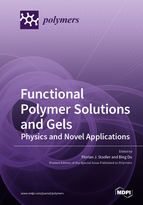Functional Polymer Solutions and Gels–Physics and Novel Applications
A special issue of Polymers (ISSN 2073-4360). This special issue belongs to the section "Polymer Physics and Theory".
Deadline for manuscript submissions: closed (31 August 2019) | Viewed by 52606
Special Issue Editors
Interests: nanomaterials science; polymer science; soft matter science; 2D materials; environmental chemistry
Special Issues, Collections and Topics in MDPI journals
Interests: functional polymers; polyolefins; supramolecular bonding; rheology and advanced mechanics; electrospinning; ion- and thermoresponsive polymers; gas sensing; photocatalysis
Special Issue Information
Dear Colleagues,
Recent years have seen significant improvements in the understanding of functional soft matter. Advances in organic chemistry have identified a vast variety of possible interactions, ranging from hydrophobic interactions, e.g., based on cyclodextrin or hydrophobic end-capping, host–guest interactions, multiple hydrogen bonding, such as 2-ureido-4[1H]-pyrimidinone (UPy) to metal–ligand bonding, such as terpyridines and catechols. Those functional moieties can link polymer-chains, usually in aqueous solution, and thus assemble solutions into gels. These discoveries of the last ca. 30 years by chemists worldwide have made it possible to understand biological soft matter significantly better, as well as to create our own soft materials with tailored properties, such as a pH-controlled behavior. Their current and future applications are often focused on the biomedical field, particularly on drug release and tissue engineering. However, functional polymer solutions and gels can also be envisioned for many other applications. For example, functional nanofibers electrospun from solution can be used for advanced applications as well. The resulting nanofibers combine an incredible high specific surface area with an excellent performance as membranes with high flux, good separator selectivity, as well as extraordinary selective absorption for both functional nanoparticles and pollutants in water.
The aim of this Special Issue is to highlight the progress and fundamental aspects in the physical properties and applications of functional polymer melts and solutions, as well as of products derived from those. The topics to be included in this Special Issue are on functional polymer solutions and gels of all kinds with respect to understanding their physical properties and/or their application for, e.g., tissue engineering, drug delivery, and functional nanostructures.
Prof. Florian Stadler
Prof. Dr. Bing Du
Guest Editors
Manuscript Submission Information
Manuscripts should be submitted online at www.mdpi.com by registering and logging in to this website. Once you are registered, click here to go to the submission form. Manuscripts can be submitted until the deadline. All submissions that pass pre-check are peer-reviewed. Accepted papers will be published continuously in the journal (as soon as accepted) and will be listed together on the special issue website. Research articles, review articles as well as short communications are invited. For planned papers, a title and short abstract (about 100 words) can be sent to the Editorial Office for announcement on this website.
Submitted manuscripts should not have been published previously, nor be under consideration for publication elsewhere (except conference proceedings papers). All manuscripts are thoroughly refereed through a single-blind peer-review process. A guide for authors and other relevant information for submission of manuscripts is available on the Instructions for Authors page. Polymers is an international peer-reviewed open access semimonthly journal published by MDPI.
Please visit the Instructions for Authors page before submitting a manuscript. The Article Processing Charge (APC) for publication in this open access journal is 2700 CHF (Swiss Francs). Submitted papers should be well formatted and use good English. Authors may use MDPI's English editing service prior to publication or during author revisions.
Keywords
- polymer solution
- supramolecular bonding
- polymer gel
- stimuli-responsiveness
- polymer physics
- rheology
- functional membrane
- advanced nanofiber








